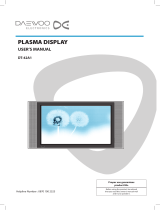
Symbols
☛ ➢
Press
Important
Note
Contents
General Information
User Instructions ............................................. 2
Checking Parts ................................................ 4
Using the Stand-Base ..................................... 4
Control Panel ................................................. 5
Connection Panel ............................................ 6
Viewing the Remote Control
(depending on the model) ............................... 8
Operation
Switching Your Television On and Off ............. 9
Viewing the Menus ........................................ 10
Freezing the Current Picture ......................... 10
Plug & Play Feature ...................................... 10
Viewing an External Signal Sources ............. 12
Editing Device Names ................................... 12
Channel Control
Storing Channels Automatically .................... 13
Sorting the Stored Channels ......................... 13
Storing Channels Manually ........................... 14
Adding / Locking Channels ........................... 15
Assigning Names to Channels ...................... 16
Fine Tuning Channel Reception .................... 16
Picture Control
Changing the Picture Standard ..................... 17
Customizing the Picture Settings .................. 17
Configuring Detailed Settings on the Picture
.. 18
Selecting the Picture Size ............................. 19
Digital NR / Active Colour / DNIe / Movie Plus
... 20
Sound Control
Sound Features ............................................ 21
Selecting the Sound Mode
(depending on the model) ............................. 22
Function Description
Time Features ............................................... 23
Language / Blue Screen / Melody / Light Effect /
Energy Saving / HDMI Black Level
.................. 24
Using the Game Mode .................................. 25
Wall- mount adjustment (Sold separately) .... 25
Viewing the Picture in Picture (PIP) .............. 26
Screen Burn Protection ................................. 27
PC Display
Setting up Your PC Software
(Based on Windows XP) ............................... 28
Input Mode (PC) ............................................ 29
Setting the PC ............................................... 30
Setting the Home Theatre PC ....................... 31
About Anynet
+
What is Anynet
+
? .......................................... 32
Connecting Anynet
+
Devices ........................ 32
Setting Up Anynet
+
....................................... 33
Scanning and Switching between Anynet
+
Devices ......................................................... 33
Recording ...................................................... 34
Listening through a Receiver ........................ 35
Check Points before Requesting Service ..... 35
Appendix
Teletext Feature (depending on the model) .. 36
Setting Up Your Remote Control ................... 38
Installing the Wall Mount Kit .......................... 43
How to assemble the Stand-Base
(depending on the model) ............................. 44
Troubleshooting ............................................ 44
Specifications ................................................ 45
BN68-01131D-01Eng.indd 3 2007-03-21 ソタネト 7:20:38





















